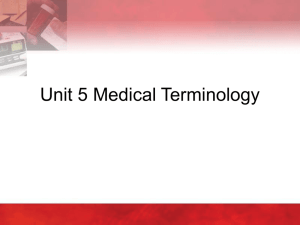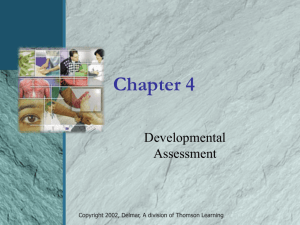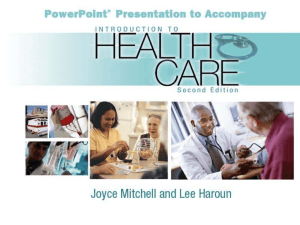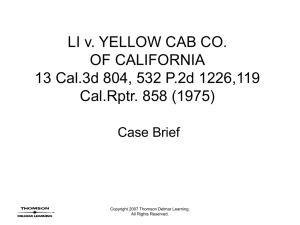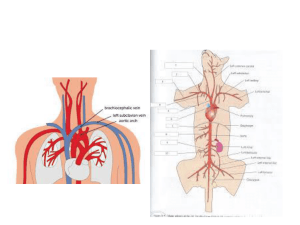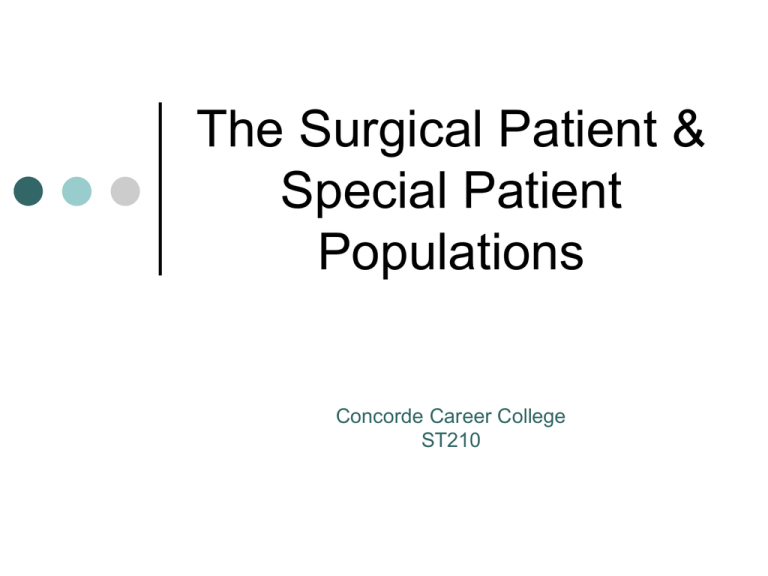
The Surgical Patient &
Special Patient
Populations
Concorde Career College
ST210
Objectives
List and differentiate between the
preoperative duties of the circulator and
the surgical technologist in the scrub role
Identify the biological needs of the
patient and identify fundamental patient
care elements used to meet these needs
in the surgical environment
Objectives
Identify the psychological needs of the
patient and identify fundamental patient
care elements used to meet these needs
in the surgical environment
Identify the social needs of the patient
and identify fundamental patient care
elements used to meet these needs in
the surgical environment
Objectives
Identify the spiritual needs of the patient
and identify fundamental patient care
elements used to meet these needs in
the surgical environment
Identify the cultural needs of the patient
and identify fundamental patient care
elements used to meet these needs in
the surgical environment
Objectives
Identify the needs of special patient
populations (e.g., pediatric, geriatric,
immunocompromised) and identify
fundamental patient care elements used
to meet those needs in the surgical
environment
Team Members
Surgical Team Members
Team Members
Who are the surgical team members
and what are their roles?
Needs of the Patient
Needs of the Patient
Needs of the Patient
Maslow’s Hierarchy of
Needs
Needs of the Patient
Biological Needs (also called
physical, physiologic)
Necessary for Life
Oxygen
Nutrition
(water, food)
Regulation of body processes
(sleep, fluid balance, O2/CO2
exchange, temperature
regulation, elimination of waste)
Needs of the Patient
Safety Needs
Perception that one’s environment is
safe
Needs of the Patient
Love and Belonging Needs
Basic social needs
To be known and cared for as an
individual
To care for another (others)
Needs of the Patient
Prestige & Esteem Needs
Need to have a positive evaluation of
oneself and others
Need to be respected and respect
others
Needs of the Patient
Self Actualization
Need to fulfill what is believed to be
one’s purpose
Needs of the Patient
Psychological Needs
Any need or activity related to the
identification and understanding of
oneself
Fear
Loss of security
Family issues
Needs of the Patient
Social Needs
Any
need or activity related to
one’s identification or
interaction with another
individual or group
Needs of the Patient
Spiritual Needs
Any
need or activity related to
the identification and
understanding of one’s place in
an organized universe
Needs of the Patient
Cultural Needs
Every
culture has different
beliefs and value orientations
Cultural values will specify the
way the patient thinks and feels
about these values
Special Patient
Populations
19
© 2004 by Delmar Learning, a division of
Thomson Learning, Inc. All Rights Reserved.
Patients with Special Needs
Surgical patients with special needs
present various challenges
Unique physical and psychological
needs
Surgical technologists must be aware
of those needs
20
© 2004 by Delmar Learning, a division of
Thomson Learning, Inc. All Rights Reserved.
Special Needs Patients
Unique physical & psychological
needs
Pediatrics
Immunocompromised
Pregnant
Diabetic
Disabled
Obese
Geriatric
21
© 2004 by Delmar Learning, a division of
Thomson Learning, Inc. All Rights Reserved.
Pediatrics
Developmental levels and
Biological differences
Neonate - birth to 28
days
Infant – 1–18 months
Toddler – 18-30
months
Preschooler – 30
months to 5 years
School age – 6-12
years
Adolescent – 13-18
years
Monitoring the Pediatric
Patient
Temperature
Urine output
(collection bag/no
catheter)
Cardiac function
23
Intra-arterial
measurement
Central Venous
Catheter
Oxygenation
(ABG’s)
© 2004 by Delmar Learning, a division of
Thomson Learning, Inc. All Rights Reserved.
Shock in the Pediatric
Patient
Septic Shock
• Caused by gram-negative bacteria
• Intestinal perforation, UTI, URI
Hypovolemic Shock
• Common cause: Dehydration
• Treated by quick fluid and blood
replacement
24
© 2004 by Delmar Learning, a division of
Thomson Learning, Inc. All Rights Reserved.
Fluids & Electrolytes/
Infection
Monitoring fluids & electrolytes
Infection
• Monitoring
• Antibiotics
25
© 2004 by Delmar Learning, a division of
Thomson Learning, Inc. All Rights Reserved.
Metabolic & Nutritional
Responses
26
A gastrostomy
feeding tube is
usually placed after
GI surgery
© 2004 by Delmar Learning, a division of
Thomson Learning, Inc. All Rights Reserved.
Pediatric Trauma Concerns
27
Emotional
reactions differ
from those of an
adult
Hypothermia
Torticollis
Blunt trauma
Motor vehicle
accidents
Falls
© 2004 by Delmar Learning, a division of
Thomson Learning, Inc. All Rights Reserved.
Pediatrics
Accidents are the
number one cause of
death in children
ages 1-15.
Approximately 20
million childhood
injuries result in
death or permanent
disability annually
Obesity
Obesity – defined by
BMI
•An adult who has a
BMI between 25 and
29.9 is considered
overweight.
•An adult who has a
BMI of 30 or higher
is considered obese.
Obesity Scale
Height
5' 9"
Weight Range
BMI
Considered
124 lbs or less
Below 18.5
Underweight
125 lbs to 168
lbs
18.5 to 24.9
Healthy weight
169 lbs to 202
lbs
25.0 to 29.9
Overweight
203 lbs or more
30 or higher
Obese
Care of Obese Patients
31
Patient whose body weight is 100 pounds greater
than ideal weight
Physiological disease conditions related to obesity
• Myocardial hypertrophy
• Coronary artery disease
• Hypertension & vascular changes of the kidneys
• Varicose veins and edema
• Pulmonary Functions
• Liver & Gallbladder Disease
• Diabetes
• Osteoarthritis
• Pituitary abnormalities
© 2004 by Delmar Learning, a division of
Thomson Learning, Inc. All Rights Reserved.
Gastric Bypass
(Bariatric Surgery)
What is Morbid Obesity?
33
Morbid Obesity is a serious disease
process, in which the accumulation of
fatty tissue on the body becomes
excessive, and interferes with, or
injures the other bodily organs,
causing serious and life-threatening
health problems, which are called comorbidities.
© 2004 by Delmar Learning, a division of
Thomson Learning, Inc. All Rights Reserved.
Indications
34
Gastric bypass surgery is recommended only for
patients who are morbidly obese. Usually more than
100 pounds overweight, these individuals have major
health problems related to their weight.
The Body Mass Index BMI is typically used to identify
surgery candidates with a cut-off of 40 being used by
most surgeons. BMI’s down to 35 are typically
permitted if the individual has other serious health
issues.
Gastric bypass is overwhelmingly successful, with
many patients losing over 100 pounds within the first
18 months following surgery. Gastric bypass surgery
should always be accompanied by an exercise
regimen.
© 2004 by Delmar Learning, a division of
Thomson Learning, Inc. All Rights Reserved.
Gastric Bypass Surgery
Today, there are several surgical
procedures used for achieving
weight loss. The most common are:
:
Roux-en-Y gastric bypass
Lap-Band
35
© 2004 by Delmar Learning, a division of
Thomson Learning, Inc. All Rights Reserved.
Comparison between the Lap-Band
& Gastric Bypass procedures
Lap-Band
Gastric Bypass
Less invasive
Outpatient surgery
Reversible
Adjustable
No rearrangement of
anatomy
Slower weight loss
Not endorsed by NIH
Less well studied in US
More follow-up required
More dietary compliance
required
More invasive
Inpatient surgery
Not easily reversible
Not adjustable
Anatomy rearranged
Faster weight loss
Endorsed by NIH
Well studied in US
Less follow-up required
Less dietary compliance
required
36
© 2004 by Delmar Learning, a division of
Thomson Learning, Inc. All Rights Reserved.
Gastric Bypass Surgery
Roux-en-Y Anastamosis
Laparoscopic Banding
37
© 2004 by Delmar Learning, a division of
Thomson Learning, Inc. All Rights Reserved.
The Procedure…
The patient is placed in the supine
position and trocars are placed appropriately.
38
© 2004 by Delmar Learning, a division of
Thomson Learning, Inc. All Rights Reserved.
The stomach is sized to a small pouch by first identifying the esophago gastric junction and then passing a Baker tube filled with 15 cc of saline
solution. The Endo GIA stapler (US Surgical), 60 mm long with 4.8 mm
staples is then fired three times as shown in this figure.
39
© 2004 by Delmar Learning, a division of
Thomson Learning, Inc. All Rights Reserved.
The stomach is sized to a small pouch by first identifying the
esophago-gastric junction and then passing a Baker tube filled with
15 cc of saline solution. The Endo GIA stapler (US Surgical), 60 mm
long with 4.8 mm staples is then fired three times as shown in this
figure.
40
© 2004 by Delmar Learning, a division of
Thomson Learning, Inc. All Rights Reserved.
In order to create the Roux-limb, the jejunum is divided 15
cm beyond the ligament of Treitz by using an Endo GIA II
stapler (US Surgical), 45 mm long with 3.5 mm staples. In
addition the mesentery is also divided with a Endo GIA II
stapler, but this time using the vascular load (45 mm length,
2.0 mm staples). This maneuver will facilitate mobilization of
the small intestine through the mesocolon. A rubber drain is
sutured to the jejunum to help with the pulling.
41
© 2004 by Delmar Learning, a division of
Thomson Learning, Inc. All Rights Reserved.
42
The Roux-limb is measured
according to the patient BMI
(Body Mass Index) and can
range from 75 to 200 cm in
length. Notice that the
laparoscopic grasper is used
as a ruler.
© 2004 by Delmar Learning, a division of
Thomson Learning, Inc. All Rights Reserved.
An end-to-side anastomosis between the proximal jejunum and the
roux limb is created by firing two Endo GIA II staplers. The
enterotomy is closed using another load of staples. The mesentery
is also closed to prevent bowel entrapment (internal hernias).
43
© 2004 by Delmar Learning, a division of
Thomson Learning, Inc. All Rights Reserved.
44
Close up view of the
enteroenterostomy
© 2004 by Delmar Learning, a division of
Thomson Learning, Inc. All Rights Reserved.
45
The Roux-limb is now advanced trough the mesocolic
window (retrocolic and retrogastric) near the transected
stomach.
© 2004 by Delmar Learning, a division of
Thomson Learning, Inc. All Rights Reserved.
Using the rubber drain, the Roux-limb is pulled to a
retrogastric position
46
© 2004 by Delmar Learning, a division of
Thomson Learning, Inc. All Rights Reserved.
Following an enterotomy an anastomosis between the
gastric pouch and the Roux-limb is created by firing a Endo
GIA II.
47
© 2004 by Delmar Learning, a division of
Thomson Learning, Inc. All Rights Reserved.
The enterotomy is stapled shut with another load of Endo
GIA II. The anastomosis is secured by placing an extra row
of stitches. The gastrojejunostomy and the enterotomy site
are tested for leakage by applying insufflation through an
nasogastric tube (or endoscope) and submerging the area
in irrigation solution.
48
© 2004 by Delmar Learning, a division of
Thomson Learning, Inc. All Rights Reserved.
Lifetime Commitment
Undergoing a gastric bypass requires patients to commit to a new lifestyle.
They will no longer be able to eat large portions of food at one sitting, nor will
they be able to eat foods high in sugar or fat, which often result in dumping
syndrome, an unpleasant feeling of faintness caused by the sudden
absorption of these foods in the shortened digestive tract. Due to the limited
amount patients can take in at any one time, they must constantly drink
small amounts of water or risk dehydration.
The operation while highly successful does have a morbidity rate of
approximately 2% overall. 1% having immediate complications and death
another 1% will commonly have post operative complications that lead to
death within one month of surgery. This can be mitigated by compliance with
the surgeon's post operative plan and using a Doctor who has performed
more then 200 procedures.
49
However it should be noted that a full 25% of people undergoing this
operation will have some form of post operative complication either requiring
a further procedure or change in habits.
© 2004 by Delmar Learning, a division of
Thomson Learning, Inc. All Rights Reserved.
Diabetes Mellitus
Type I (IDDM)
Type II (NIDDM)
50
Insulin dependent: The pancreas
produces little or no insulin
Non insulin dependent: The pancreas
produces different amounts of insulin
© 2004 by Delmar Learning, a division of
Thomson Learning, Inc. All Rights Reserved.
Care of Diabetic Patients
Insulin and glucose must be
monitored
IV access
Avoid metabolic crisis
Antiembolic stockings required
Postoperative compression boots
51
© 2004 by Delmar Learning, a division of
Thomson Learning, Inc. All Rights Reserved.
Complications Associated
with Diabetes
52
Infection
Dehydration
Poor circulation
Myocardial Infarction
Delayed wound healing
Control of blood sugar
Neuropathic skeletal disease
Neurogenic bladder
Retinopathy
Coronary Artery Disease
Thrombophlebitis
Tachycardia
© 2004 by Delmar Learning, a division of
Thomson Learning, Inc. All Rights Reserved.
Pregancy
The Pregnant Surgical
Patient
Surgical procedures in first trimester
avoided
Anesthesia
Abdominal organs displaced from
normal position
Physiological assessment is difficult
54
© 2004 by Delmar Learning, a division of
Thomson Learning, Inc. All Rights Reserved.
Fetal Surgery
55
© 2004 by Delmar Learning, a division of
Thomson Learning, Inc. All Rights Reserved.
Immunocompromised
Patients
HIV+
Multiple sclerosis
Lupus erythematosus
Rheumatoid arthritis
Transplant recipients
Steroid use
(Cushing’s syndrome)
Patient undergoing
radiation or
chemotherapy
Care of
Immunocompromised
Patients
Additional personnel to move patient
Possible difficult intubation
IV placement is difficult
Grounding pad placement could be
difficult
57
© 2004 by Delmar Learning, a division of
Thomson Learning, Inc. All Rights Reserved.
Surgical Intervention
Required
Peritonitis secondary to
cytomegaloviris
Non-Hodgkin’s lymphoma of GI tract
Kaposi’s sarcoma of the GI tract
Mycobacterial infection of
retroperitoneum or spleen
HIV/AIDS (splenomegaly,
diagnostic biopsies)
58
© 2004 by Delmar Learning, a division of
Thomson Learning, Inc. All Rights Reserved.
Disabled Patients
Geriatrics
Biological
differences
Geriatric Patients
Usually over the age of 65
Chronic debilitation
Decreased physiologic status
Visual impairments
Hearing impairments
61
© 2004 by Delmar Learning, a division of
Thomson Learning, Inc. All Rights Reserved.
Other Special Needs
Patients
Hearing impaired
Visually impaired
Physically disabled
62
© 2004 by Delmar Learning, a division of
Thomson Learning, Inc. All Rights Reserved.
Trauma Patients
“Golden Hour”
Trauma Centers
•
•
•
•
Level I
Level II
Level III
Level IV
Blunt Trauma
Penetrating Trauma
63
© 2004 by Delmar Learning, a division of
Thomson Learning, Inc. All Rights Reserved.
Trauma Scoring
64
Eye Opening Response
Spontaneous--open with
blinking at baseline 4 points
To verbal stimuli, command,
speech 3 points
To pain only (not applied to
face) 2 points
No response 1 point
Verbal Response
Oriented 5 points
Confused conversation, but
able to answer questions 4
points
Inappropriate words 3 points
Incomprehensible speech 2
points
No response 1 point
Motor Response
Obeys commands for movement 6
points
Purposeful movement to painful
stimulus 5 points
Withdraws in response to pain 4
points
Flexion in response to pain
(decorticate posturing) 3 points
Extension response in response to
pain (decerebrate posturing) 2
points
No response 1 point
Categorization:
Coma: No eye opening, no ability to
follow commands, no word
verbalizations (3-8)
Head Injury Classification:
Severe Head Injury----GCS score of
8 or less
Moderate Head Injury----GCS score
of 9 to 12
Mild Head Injury----GCS score of 13
to 15
© 2004 by Delmar Learning, a division of
Thomson Learning, Inc. All Rights Reserved.
Preservation of Evidence
Violent crime items must be preserved
for law enforcement
Physical evidence must be handled
carefully
Facility policy must be strictly followed
65
© 2004 by Delmar Learning, a division of
Thomson Learning, Inc. All Rights Reserved.
Other Considerations for the
Trauma Patient
Hypothermia
Infection
Preparation of the case
66
© 2004 by Delmar Learning, a division of
Thomson Learning, Inc. All Rights Reserved.
The End

